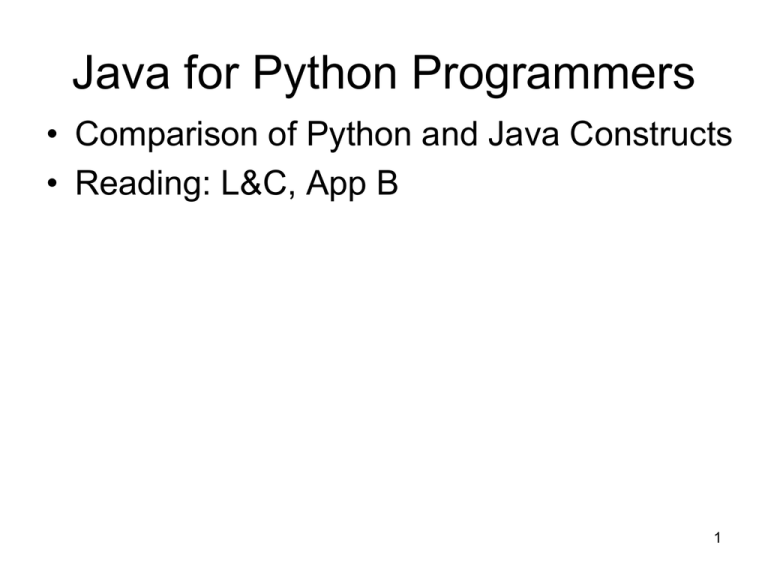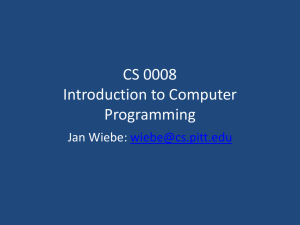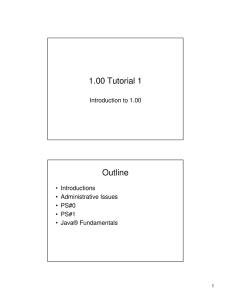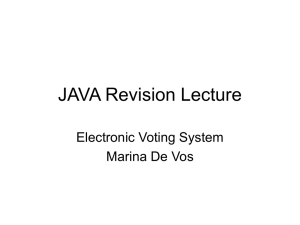Java for Python Programmers • Comparison of Python and Java Constructs 1
advertisement

Java for Python Programmers
• Comparison of Python and Java Constructs
• Reading: L&C, App B
1
General Formatting
• Shebang
• Shebang
#!/usr/bin/env python
Never used or required in Java source code
# comments for human readers - not code
statement
# comments to end of line
// comments for human readers – not code
statement;
// comments to end line
“”” start of multiple lines of comments
end of multiple lines of comments “””
/* start of multiple lines of comments
end of multiple lines of comments */
• Program Statements
• Program Statements
name = expression
(type) name = expression; // must end with ;
• Blocks (Indenting)
• Blocks (Curly Braces)
(maybe indented) a statement ending with :
(indented to next level) starting statement
(indented to same level) . . .
(indented to same level) ending statement
(indented to original or fewer levels)
{
• Comments
• Comments
starting statement;
...
ending statement;
} // indenting is used only for readability!!
Key Words / Reserved Words
• Python Key Words
and
as
assert
break
class
continue
def
del
elif
else
except
exec
finally
for
from
global
if
import
in
is
lambda
not
or
pass
print
raise
return
try
• Java Reserved Words
while abstract default
goto*
package this
with assert
do
if
private
throw
yield boolean double
implements protected throws
break
else
import
public
transient
byte
enum
instanceof return
true
case
extends int
short
try
catch
false
interface static
void
char
final
long
strictfp
volatile
Notes:
class
finally
native
super
while
Words in green are not reserved in Java and const*
float
new
switch
can be used as identifiers, etc.
continue for
null
synchronized
* Are reserved words, but are not used.
There are also some type and constant names:
int, float, True, False, None, etc.
Notes:
that correspond to reserved words in Java
Words in black have generally the same
maybe with different spelling or capitalization: semantics in Java as they do in Python.
int, float, true, false, null, etc.
If you have been using any of the red words in
Python, you will need to avoid using them in Java
Primitive Data Types
• Numeric Data Types
• Numeric Data Types
------int
long
float
--complex
byte
char
short
int
long
float
double
Natural Numbers (Integers)
Large Natural Numbers
Real Numbers (Decimal)
8 Bit Numbers
16 Bit Unicode Characters
16 Bit Numbers
32 Bit Numbers
64 Bit Numbers
Real Numbers (Decimal)
Larger/Smaller Real Numbers
Complex Numbers (R + I * j)
• Other Data Types
• Other Data Types
boolean Logical “True” or “False” values
class
Any defined class as a type
string
An array of characters
---
boolean
Class
String
Interface
Logical “true” or “false” values
Any defined class as a type
A somewhat special class
Any defined interface as a type
Primitive Data Constants
• Type int / long
• Type int / long
Decimal
Octal
Hex
Binary
long
Decimal 123
# 12310
Octal
0123
# 8310
Hex
0x123
# 29110
Binary
0b101
# 510
(Java 8)
long
1234567890123456789L
Note: In Java, long has a smaller maximum
number of digits than in Python
123
# 12310
0123
# 8310
0x123
# 29110
0b101
# 510
1234567890123456789L
• Type float
float
float
float
123.0
1.23e308
1.23e-308
• Type float / double
# 123.0
float
123.0f
// 123.0
// 1.23 x 10308 float
1.23e38f
// 1.23 x 1038
// 1.23 x 10-308 float
1.23e-38f
// 1.23 x 10-38
double
1.23e308
// 1.23 x 10308
double
1.23e-308
// 1.23 x 10-308
Note: Type double is default for real in Java
Conversion needed to get desired type:
Casting needed for narrowing conversions:
i = int(123.4)
# i = 123
float f = (float) 123.4; // double to float
f = float(i)
# f = 123.0
int i = (int) f;
// float to int 123
Variables
• Declarations
All variables are “reference” types
Variables do not need to be declared.
A variable is created by initializing it
and its type is determined by the type
of the value assigned:
i = 10
# i is an int
Its type can be changed later:
i = 10.5
# i is a float now
• Declarations
There are primitive and reference variables.
All variables must be declared before use.
A variable is created by declaring it with its
data type and optionally initializing it.
A primitive variable is of a built in data type
int i = 10;
// i is an int
Its type can not be changed later:
i = 10.5;
// compilation error
A reference variable is of a user defined type
based on a class or is reference to an array:
String myString = “Hello”;
A variable can be deleted (undefined):
int [ ] myNumbers = new int[10];
del i
Using i in an expression is invalid now A variable can not be deleted (undefined).
unless it is initialized again.
Operators
• Arithmetic Operators
• Arithmetic Operators
+ add, e.g. 4 + 2 is 6
- subtract, e.g. 4 – 2 is 2
* multiply, e.g. 4 * 2 is 8
/ divide, e.g. 4 / 2 is 2 (dividend)
% modulo, e.g. 4 % 2 is 0 (remainder)
** exponentiation, e.g. 4 ** 2 is 16
Note: ++ and -- are NOT Python operators
+ add, e.g. 4 + 2 is 6
- subtract, e.g. 4 – 2 is 2
* multiply, e.g. 4 * 2 is 8
/ divide, e.g. 4 / 2 is 2 (dividend)
% modulo, e.g. 4 % 2 is 0 (remainder)
Note: ** is NOT a Java operator
++ pre/post increment by one
-- pre/post decrement by one
• Logical Operators
• Logical Operators
and and (between boolean values)
or or (between boolean values)
not not (of a boolean value)
& Bitwise and (between int values)
| Bitwise or (between int values)
^ Bitwise exclusive or (between int values)
<< Bitwise Left Shift (of an int value)
>> Bitwise Right Shift (of an int value)
&&
||
!
&
|
^
<<
>>
and (between boolean values)
or (between boolean values)
not (of a boolean value)
Bitwise and (between int values)
Bitwise or (between int values)
Bitwise exclusive or (between int values)
Bitwise Left Shift (of an int value)
Bitwise Right Shift (of an int value)
Expressions
• Operator Precedence
• Operator Precedence
Same in Python and Java (Algebraic)
Override precedence with parentheses ( )
Same in Python and Java (Algebraic)
Override precedence with parentheses ( )
• Casting / Conversions
• Casting / Conversions
Numeric Casting/Conversions
Numeric Casting/Conversions
Automatic widening type conversions,
Automatic widening type conversions,
e.g. 1 + 3.0 results in a float 4.0
e.g. 1 + 3.0 results in a double 4.0
Functions required for narrowing conversions, Casting required for narrowing conversions,
e.g. 1 + int(3.0) results in an int 4
e.g. 1 + (int) 3.0 results in an int 4
Non-numeric Conversions
Non-numeric Conversions
Need to use conversion functions,
Need to use wrapper class static methods,
e.g int(“string of digits”) which
e.g Integer.parseInt(“string of digits”) which
raises an Error for non-digit characters
throws an Exception for non-digit characters
Stand-alone Functions / Methods
• Function Definition
• No Equivalent in Java
def function (parameters):
statements
return value
A function can only be defined as a method
within the context of a class or an interface.
(See Classes)
• Invoking a Function
• Invoking a Method
# no context of an object or class is required
// the context of an object or class is required
returnValue = function( . . .)
e.g.
length = len(myString)
// instance method (non static)
type returnValue = object.method( . . .);
e.g.
int length = myString.length();
// using a function defined in the library
returnValue = packageName.function(. . .)
e.g.
import math
# library package name
c = math.sqrt(2.0) # 1.414…
// static method (defined in a class, e.g. Math)
type returnValue = Class.method( . . .);
e.g.
// Note: Math class is automatically imported
double root = Math.sqrt(2.0); // 1.414…
String Data Type
• Strings
• String Class / char
myString = “Hello World”
myString = ‘Hello World’
myString = “””Hello World”””
Note: “\n” is end of line in a string
String myString = “Hello World”;
char c = ‘a’;
// ‘a’ = char constant for letter a
Note: ‘\n’ is end of line in a char
Note: “\n” is end of line in a String
• String Functions
• String Methods / char
n = len(myString)
c = myString[0]
s = myString[0 : 2]
s = myString.upper()
int n = myString.length();
// n = 11
char c = myString.charAt(0);
// c = ‘H’
String s = myString.substring(0, 2); // s = “He”
s = myString.toUpperCase();
// “HELLO”
# n = 11
# c = “H”
# s = “He”
# s = “HELLO”
• String Operations
• String Operations
s = myString + “!”
# Concatenation
s = myString + str(42) # HelloWorld42
myString == “Hello World” # True
s = myString + “!”;
// Concatenation
s = myString + 42;
// HelloWorld42
myString.equals(”Hello World”)
// true
Multi-valued Data Types
• Lists
• Arrays
Python lists are a dynamic data structure.
Java arrays are a FIXED data structure.
Syntax for a Java array looks like a Python list,
BUT THE SEMANTICS ARE DIFFERENT!
anEmptyList = [ ]
# type unspecified
myList = [“you”, “me”, “him”, “her”]
length = len(myList)
#4
myList[0]
# “you”
int [ ] anEmptyArray= new int[10] // type int
String [ ] myList = {“you”, “me”, “him”, “her”};
int length = myList.length;
// 4
myList[0]
// “you”
myList[3]
# “her”
myList[0] = “thee” # update an element
myList[3]
myList[0] = “thee”;
List methods in Python:
myList.sort()
# sort the elements
myList.reverse() # reverse the elements
myNums.append(5) # add an element
myNums.remove(3) # remove one
There are NO methods for a Java array
No equivalent with Java arrays
No equivalent with Java arrays
No equivalent with Java arrays.
No equivalent with Java arrays.
Length of a Java array can’t be changed.
Must use Java Collections class ArrayList<T>.
We will cover collection classes in CS210.
// “her”
// update an element
Multi-valued Data Types
• Tuples
• No Equivalent Type in Java
person = (“Diana”, 32, “New York”)
person[0]
# “Diana”
person[1]
# 32
person[2]
# “New York”
person[0] = “Amy” # not allowed
person = person + person (concatenate)
Person[3]
# “Diana” (again)
• Dictionaries
words = { }
# empty
words[“Hello”] = “Bonjour”
words[“Goodbye”] = “Adieu”
words[“Hello”]
words[“Yes”]
KeyError: “Yes”
# “Bonjour”
# raises an Error
A Java object can be used as a specific “tuple”.
Define a class with the needed combo of types.
- Attributes of the class are the items.
- Setter and getter methods allow access - not [ ]
BUT:
Java can allow updating of item values.
We can NOT concatenate objects (except String)
(See Classes)
• No Equivalent Type in Java
Must use a Java Collections map class
e.g. HashMap<K,V> or TreeMap<K,V>.
We will cover these classes in CS210.
Flow of Control Statements
• If / Else
• If / Else
if boolean expression:
statement1 or block1
else:
# optional
statement2 or block2
if (boolean expression)
statement1; or {block1}
else
// optional
statement2; or {block2}
May nest “if” or “else” inside “if” or “else”
May nest “if/else” inside “if” or “else”
Python “elif” must be “else if” in Java
Conditional Expression Evaluation Conditional Expression Evaluation
Not supported in Python
boolean expression ? true expr : false expr
Conditional Boolean Operators
Conditional Boolean Operators
==
!=
>
<
==
!=
>
<
equal
not equal
greater than
less than
equal
not equal
greater than
less than
Flow of Control Statements
• For
• For
for i in range(0, 10, 1):
statement or block using i
for (int i = 0; i < 10; i++)
single statement; or {block}
for item in items:
# items is a list
statement or block using item
// sometimes referred to as a “for-each” loop
for (type item : items)
// items is an array
single statement; or {block}
• While
• While
while boolean expression:
statement or block for body of loop
while (boolean expression)
single statement; or {block}
• Do . . . while
do
Note: Loops may be nested in Python and Java
// always executes body once
single statement; or {block}
while (boolean expression);
Input / Output
• Input (Command Line)
• Input (Command Line)
python script.py tokens separated by spaces java classname tokens separated by spaces
• Program Arguments
• Main Method Arguments
Note: No main function header is required
import sys
# but import is required
n = len(sys.argv)
#n=5
firstArg = sys.argv[0]
# “script.py”
...
lastArg = sys.argv[4]
# “spaces”
public static void main (String[ ] args)
{
int n = args.length;
// n = 4
String firstArg = args[0]; // “tokens”
...
String lastArg = args[3]; // “spaces”
# if second token should be an integer,
n = int(sys.argv[1])
// if first token should be an integer,
int n = Integer.parseInt(arg[0]);
# if last token should be a float,
f = float(sys.argv[4])
// if last token should be a double,
double d = Double.parseDouble(arg[3]);
}
Input / Output
• Typed Outputs to User
• Typed Outputs to User
print (“Text String”)
System.out.println(“Text String”);
• User Prompt/Response • User Prompt/Response
s = input(“Prompt”)
n = int(input(“Prompt:”))
f = float(input(“Prompt:”))
// token
// integer
// real
import java.util.Scanner; // at beginning of file
...
Scanner keyboard = new Scanner(System.in);
System.out.println(“Prompt:”);
String s = keyboard.next();
// token
int n = keyboard.nextInt();
// integer
float f = keyboard.nextFloat();
// real
double d = keyboard.nextDouble(); // double
boolean b = keyboard.nextBoolean(); // boolean
File Input: Example
import java.util.Scanner;
import java.io.*;
public class FileDisplay
{
public static void main (String [] args)
throws IOException
{
Scanner scan = new Scanner(System.in);
System.out.println("Enter name of file to display");
File file = new File(scan.nextLine()); // open file
Scanner fileScan = new Scanner (file);
while (fileScan.hasNext())
System.out.println(fileScan.nextLine());
}
}
17
File Output: Example
import java.util.Scanner;
import java.io.*;
public class FileWrite
{
public static void main (String [] args)
throws IOException
{
Scanner scan = new Scanner(System.in);
System.out.println("Enter name of file to display");
File file = new File(scan.nextLine()); // open file
PrintStream out = new PrintStream(file);
while (scan.hasNext()) {
String line = scan.nextLine(); // read keyboard
out.println(line);
// write file
}
out.close();
// close file
}
}
18
• Errors
Errors / Exceptions
• Exceptions
Because Python code is interpreted, many
syntax errors are detected only at run time.
>>> while True print ‘Hello World’ # no :
while True print ‘Hello World’
^
SyntaxError: invalid syntax
In Java, all syntax errors are caught during
compilation and before run time.
To raise an error in your code:
if something bad would happen:
raise NameOfError(“text”)
To throw an exception in your code:
if (something bad would happen)
throw new NameOfException(“text”);
To handle a run time error - not syntax error
try:
statements that could raise an error
except nameOfError:
statements to recover from the error
else:
statements executed if no error raised
To handle an exception in your code:
try {
statements that may throw an exception
} catch (NameOfException e) {
statements to recover from the exception
} finally {
statements to execute regardless
}
Exceptions occur during runtime only if:
1. JVM can’t execute, e.g. int divide by 0
2. Code throws an exception object





